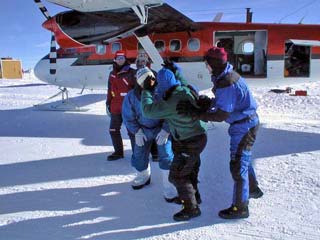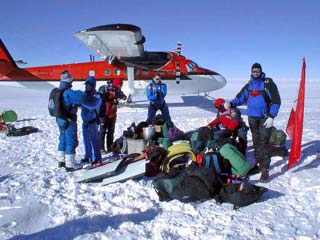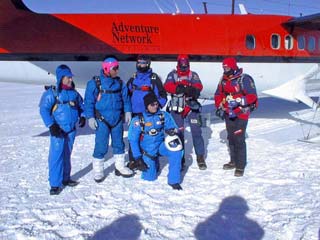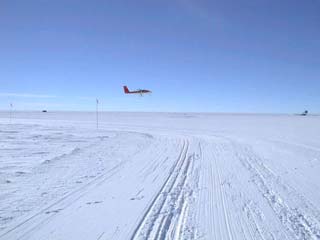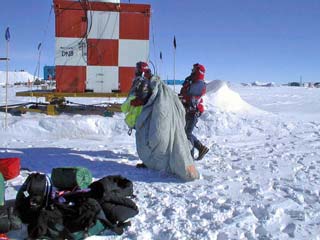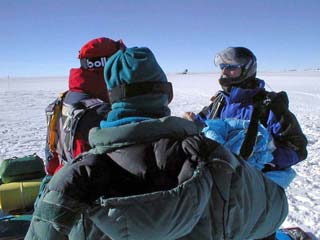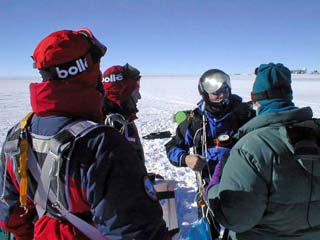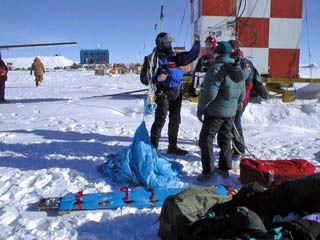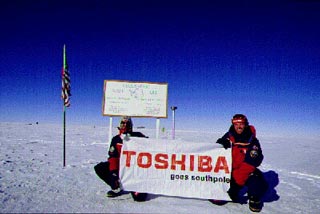1997 Skydiving Tragedy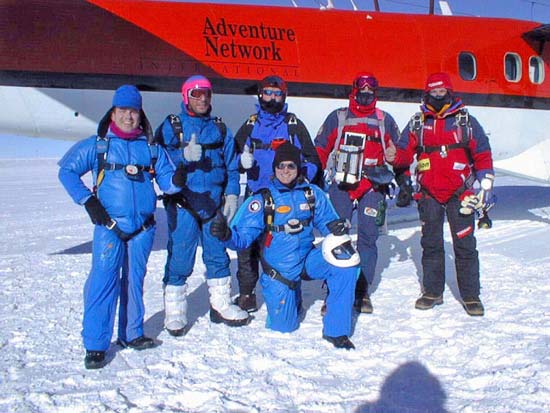 The pre-jump team photo at Pole. Back row from left: Ray Miller, Hans Rezac, Michael Kearns, Trond Jacobsen, and Morten Halvorsen. Kneeling in front: Steve Mulholland (photo from the original February 1998 Outside article, the photo is no longer online). In early December 1997, six skydivers headed south from Patriot Hills (PH) on an ANI Twin Otter. Their plans were to skydive above the South Pole, and they'd shelled out $22,000 for the opportunity. Their venture was organized by the same group that would later coordinate the 1999-2000 "Millennium Expedition" to Pole. The first part of their adventure had gone well...from their time camping out at PH where they worked out the details of the mission...to their landing at Pole at 0700 on 7 December. There they laid out a large orange square tarp as a landing target, and also posed for a "thumbs up" photo (above). The plan was to fly to 9,000 feet above ground level . From that altitude, the Austrian Hans Rezac (age 49) and the three Americans: Ray Miller (43, the trip's coordinator), Steve Mulholland (36, the jumpmaster), and Michael Kearns (39), would jump first and do a four-way formation during their 25 seconds of free fall. The two Norwegians in the group, Trond Jacobsen (32) and Morten Halvorsen (37) (in red in the above photo) would then do a tandem jump. Two ANI personnel, a physician and a field guide, had accompanied the jumpers from PH. Below...a few pre-jump photos...with a few Polies mingled in. | ||
x | ||
x | ||
|
He looked around and saw Miller, Rezac, and Mulholland had hit the snow while still in free fall positions. They'd all reached the ground about half a mile from the target. Only Mulholland's chute had started to deploy; it had not started to inflate. Meanwhile, the two Norwegians had jumped about 20 seconds after the first group, their descent went well, and they landed safely about 400 feet from the target, where a crowd of Polies was waiting and still watching for the other parachutes. Kearns started to walk toward the jump area, and he was eventually met by people on snowmobiles who were searching for the missing jumpers. The station doctor, with members of the trauma team, located and recovered the bodies. The surviving jumpers were taken into the station to warm up...and by 1400 they and the bodies were on the way back to PH. Below...a few photos taken after everyone knew that a major tragedy had occurred. Not captioned for that reason. | ||
|
What happened? No one will ever know all of the details, but it is known that only Kearns and the two Norwegians were equipped with AAD's. Additionally, there had been an oxygen bottle aboard the aircraft, and during the ascent to the jump altitude, these three had partaken of the oxygen, while the other three jumpers had declined. The surface temperature at Pole was -25ºF with almost no wind...but the temperature at the jump altitude was close to -58ºF, and the wind chill produced by the free fall velocity may have been as low as -200ºF. The jumpers were most certainly disoriented by the lack of oxygen during the free fall...as well as the lack of visual references on the white snow surface. The tragedy left its mark on the station and all who were there...including those who had been watching from the drop zone, a couple of others who emerged from the station just in time to witness three black dots in the distance fall to the horizon, and the doctor Will Silva, who was the only Pole physician to exhaust the station's supply of body bags (archived page). One of the dead, Steve Mulholland, had worked as a USAP carpenter in three previous seasons at Pole and McMurdo...and many on station knew him.
Historical notes...the first parachute jump at Pole (well, 8 miles away) was by USAF TSGT Richard Patton, in November 1956. The first free fall jump was by VX-6 pararescue team member AE2 Jim Thomann on 23 December 1966...from 6,000 feet above ground level (earlier that season Jim was one of two jumpers to set the Antarctic free fall record of 7,000 feet above ground level over the Ross Ice Shelf). There were other jumps at Pole by the pararescue team, including this one I witnessed in January 1977. Reportedly, a Norwegian was the first NGO skydiver to jump at Pole in 1992, but I haven't located any details. And more recently in 2010, Michael Kearns, the only American survivor of this tragedy, was an unsuccessful candidate for Colorado's sixth US Congressional district--he ran as an independent write-in candidate and received a total of five votes out of over 330,000 cast. Unless noted otherwise, the photos on this page are from and courtesy of the late Dave Martin. More analysis details and information can be found in the references--which include a February 1998 Outside article (a version of the photo at the top of the page originally accompanied this article); this archived version of a 2011 article in Parachutist magazine; the diary of Trond and Morten mentioned above; this archived news article from the Findlay (Ohio) Courier which covered the death of area resident Ray Miller; pages 83-84 of Big Dead Place by the late Nicholas Johnson; and two articles from the 13 December 1997 Antarctic Sun--this front-page article by Alexander Colhoun, and this eyewitness account by Laurell Toeppen at Pole. | ||

